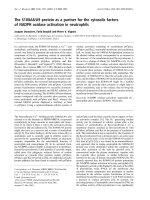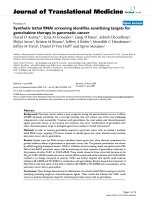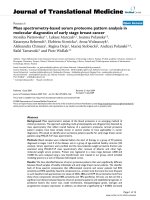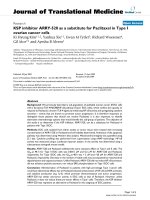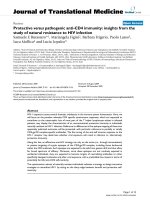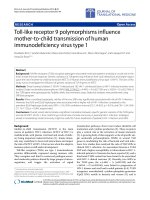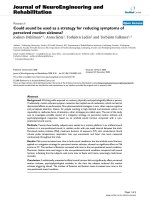Báo cáo hóa học: " Could sound be used as a strategy for reducing symptoms of perceived motion sickness?" docx
Bạn đang xem bản rút gọn của tài liệu. Xem và tải ngay bản đầy đủ của tài liệu tại đây (369.91 KB, 9 trang )
BioMed Central
Page 1 of 9
(page number not for citation purposes)
Journal of NeuroEngineering and
Rehabilitation
Open Access
Research
Could sound be used as a strategy for reducing symptoms of
perceived motion sickness?
Joakim Dahlman*
1
, Anna Sjörs
1
, Torbjörn Ledin
2
and Torbjörn Falkmer
1,3
Address:
1
Linköping University, Faculty of Health Sciences, IKE, Department of Rehabilitation Medicine, Linköping, Sweden,
2
Linköping
University, Faculty of Health Sciences, IKE, Department of Otorhinolaryngology, Linköping, Sweden and
3
Jönköping University, School of Health
Sciences, Jönköping, Sweden
Email: Joakim Dahlman* - ; Anna Sjörs - ; Torbjörn Ledin - ;
Torbjörn Falkmer -
* Corresponding author
Abstract
Background: Working while exposed to motions, physically and psychologically affects a person.
Traditionally, motion sickness symptom reduction has implied use of medication, which can lead to
detrimental effects on performance. Non-pharmaceutical strategies, in turn, often require cognitive
and perceptual attention. Hence, for people working in high demand environments where it is
impossible to reallocate focus of attention, other strategies are called upon. The aim of the study
was to investigate possible impact of a mitigation strategy on perceived motion sickness and
psychophysiological responses, based on an artificial sound horizon compared with a non-
positioned sound source.
Methods: Twenty-three healthy subjects were seated on a motion platform in an artificial sound
horizon or in non-positioned sound, in random order with one week interval between the trials.
Perceived motion sickness (Mal), maximum duration of exposure (ST), skin conductance, blood
volume pulse, temperature, respiration rate, eye movements and heart rate were measured
continuously throughout the trials.
Results: Mal scores increased over time in both sound conditions, but the artificial sound horizon,
applied as a mitigation strategy for perceived motion sickness, showed no significant effect on Mal
scores or ST. The number of fixations increased with time in the non-positioned sound condition.
Moreover, fixation time was longer in the non-positioned sound condition compared with sound
horizon, indicating that the subjects used more time to fixate and, hence, assumingly made fewer
saccades.
Conclusion: A subliminally presented artificial sound horizon did not significantly affect perceived
motion sickness, psychophysiological variables or the time the subjects endured the motion
sickness triggering stimuli. The number of fixations and fixation times increased over time in the
non-positioned sound condition.
Published: 23 December 2008
Journal of NeuroEngineering and Rehabilitation 2008, 5:35 doi:10.1186/1743-0003-5-35
Received: 10 March 2008
Accepted: 23 December 2008
This article is available from: />© 2008 Dahlman et al; licensee BioMed Central Ltd.
This is an Open Access article distributed under the terms of the Creative Commons Attribution License ( />),
which permits unrestricted use, distribution, and reproduction in any medium, provided the original work is properly cited.
Journal of NeuroEngineering and Rehabilitation 2008, 5:35 />Page 2 of 9
(page number not for citation purposes)
Background
In every environment in which people are exposed to
motion sickness, either induced by visual or physical stim-
uli, the subject may get psychologically, as well as physi-
cally, affected [1-3]. The subject's susceptibility to motion
sickness, in addition to previous experiences and anticipa-
tions related to the environment, determine the potential
development of symptoms. Initial symptoms of motion
sickness are highly individual, but typically include feel-
ings of stomach awareness, increased salivation, yawning,
dizziness and sweating [1,4]. Susceptibility to motion
sickness can also be dependent of different medical con-
ditions that facilitate the development of symptoms, both
biologically and perceptually even during very subtle
stimulation [2]. Subjects who have experienced motion
sickness will bear witness to their specific initial symp-
toms of discomfort that often follow as a result of a sub-
liminal increase in their sympathetic nervous system
activity [5,6]. For most people exposed to motions, this
initial sensation of increasing discomfort often initiates
some mitigating strategy. However, for persons who are
performing a demanding task or suffer from effects of
medication or injury and at the same time being under the
influence of motion sickness, performing deliberate miti-
gation strategies often fail. Furthermore, previous experi-
ences of motion sickness related to a specific environment
or condition often makes people attentive and more sus-
ceptible to motion sickness in that specific environment,
or in similar environments [7], i.e. anticipations play a
crucial role in the development of motion sickness.
Hence, previous experiences contribute to how we react
when exposed to motion [8,9]. However, if exposed to a
specific environment repeatedly, adaptation usually occur
after a few sessions depending on the duration of the
exposure [10].
Considerable research has been devoted to identifying the
specific autonomic responses associated with symptoms
of motion sickness and many of them are measured
together with ratings of perceived motion sickness
[1,3,5,6,11,12]. By perceived motion sickness we refer to
the state at which the symptoms of motion sickness are
strong enough to be perceived by the subject. The devel-
opment of motion sickness signs and symptoms are ini-
tially not observable or noticeable by the subject, which
means that the autonomic responses to a motion sickness
triggering stimulus starts before the subject is conscious of
that he/she is affected by motion sickness. Through meas-
urements of psychophysiological responses, the imbal-
ance between the sympathetic and parasympathetic
nervous system that normally occurs before the subject is
aware of any change in wellbeing can be observed. The
reason for using both subjective ratings and objective psy-
chophysiological measurements for identifying and stud-
ying motion sickness in this study is to better assess the
possible effects of a mitigating strategy, both on the con-
scious and unconscious level.
In many occupations in physically moving environments,
limited possibilities for visual contact with the outside
world are offered. These situations thus create good pre-
requisites for development of motion sickness symptoms;
for instance onboard ships, airplanes and inside ground
vehicles. Being under the influence of motion sickness in
these types of environments affects performance and well-
being, often to the point where interventions intended to
stop symptoms have little or no effect [13]. Medication is,
in most cases, of no use at that point in time [14]. The best
prevention, or the most symptom reducing strategy, is to
lie down as close to the centre of motion as possible and
to reduce visual input. If possible, the affected person may
also find relief in taking control of the motion by, for
example, driving the car or steering the boat. Such control
strategies require active handling, which in turn implies
that the person has to leave his/her ordinary duties for
some time [15]. As mentioned, one mitigation strategy
used to treat motion sickness is to reduce the visual stim-
uli. In environments where simply closing the eyes is not
an option, an alternative could be to reduce the stimuli
input by reducing the number of fixated objects. This
strategy also reduces the number of saccades, which fur-
ther lowers yet another motion sickness triggering factor
[16,17]. Previous research in this area has shown that
motion sickness seems to be perceived both with foveally
and peripherally presented stimuli, the latter giving rise to
more vection than the former[18].
Previous research has supported the idea that by provid-
ing a reference to the outside world in a sealed off moving
environment, the occurrence of motion sickness can be
postponed, or in some cases even be reduced to a mini-
mum [19,20]. Rolnick and Bles, [21] found that the per-
ception of motion sickness in sealed off environments
may be reduced or kept stable when subjects are provided
a visually projected horizontal reference. Another study
presented an Independent Visual Background (IVB) to a
number of subjects in a driving simulator that was in
accordance with the vestibular and visual information
perceived [22]. This visual-based artificial horizon
reduced perceptual errors and also reduced balance distur-
bance when presented in low frequencies of motion.
However, simply picking one reference stimulus without
paying further attention to the exact way this reference
stimulus is presented may prove dubious, since presenting
different reference stimuli in the same perceptual mode
could yield quite disparate outcomes [22].
Very few studies have used other means of reference sup-
port than visually presented information for possible
reduction of postural instability, vection and symptoms of
Journal of NeuroEngineering and Rehabilitation 2008, 5:35 />Page 3 of 9
(page number not for citation purposes)
motion sickness. For example, Petersen, Magnusson,
Johansson, Åkesson & Fransson. [23] used sound as a cue
in order to facilitate maintenance of postural stability and
to provide a reference that would replace visual informa-
tion. One condition provided the subject with a pitch
tone that increased in intensity when the subject leaned
forward and decreased when leaning backwards. Another
condition provided the subject with audio pulses that
gave the subject directional support in the horizontal
plane. The results indicated that when given any constant
audio feedback signal, body sway was significantly
reduced. The results illustrate the potential importance of
auditory cues for spatial orientation. Dozza, Chiari, Chan,
Rocchi, Horak and Capello [24], used audio biofeedback
(ABF) through a portable ABF-system to support subject
upright stance and postural stability. The ABF provided an
audio feedback signal when the subject leaned over, or
lost upright stance. The audio signal was converged
through a pair of headphones and the subjects were blind-
folded, standing on a thick foam plate. Results indicate
that audio biofeedback significantly reduces body sway in
healthy subjects and can be used to treat postural instabil-
ity by helping the brain to maintain posture.
Sound as a preventive countermeasure for motion sick-
ness and other vertigo related conditions has rarely
received attention. Previously mentioned research has
used sound presented either in mono or stereo. To our
knowledge, no studies using sound sources that indicate a
specific position in the environment, to support the sub-
ject's perception, have been carried out. Positioned sound
sources are commonly associated with 3D-sound and can
be experienced when attending any modern cinema. The
benefit of using positioned sound sources as a mitigating
strategy for motion sickness is that it could affect the sub-
ject subliminally and thereby not require any additional
cognitive attention. It is, however, important to keep the
stimulation as subtle as possible, in order not to add fur-
ther conflicting cues, or to enhance already experienced
symptoms. It is unlikely to assume that positioned sound
sources could eliminate symptoms completely, but a ten-
tative hypothesis is that it could postpone the onset of
perceived motion sickness or at least keep the symptoms
at a constant lower level for some time, compared to a
control condition. Hence, by supporting the subjects with
an outside reference on a subliminal level, tasks that do
require devoted attention can continue.
Aim
The aim of the study was to investigate possible impact of
a mitigation strategy on perceived motion sickness and
psychophysiological responses, based on an artificial
sound horizon compared with a non-positioned sound
source.
Methods
The study had a within-group design and was performed
in a controlled laboratory setting.
Subjects
The subjects were recruited through public advertise-
ments. Applicants with perceived high susceptibility to
motion sickness symptoms were of special interest and
therefore selected for participation. Individuals with ves-
tibular and or hearing dysfunctions, or who were on med-
ication that could confound the psychophysiological
measurements and/or contribute to nausea were
excluded. A total of 6 men and 17 women, (mean age 29.0
years, range 20–51 years) volunteered to take part in the
study. Written consent was obtained from the subjects
after informing them of the possibility of acquired dis-
comfort from exposure to motion stimulation. They were
also informed of the right to withdraw from the experi-
ment at any time without stating a reason. The subjects
completed a screening questionnaire concerning their
previous experiences of, and susceptibility to, motion
sickness. The screening questionnaire was administered to
explain possible outcome of the motion exposure and to
create a better basis for the symptoms susceptibility
among the subjects and was created by the authors based
on experiences from previous studies. The subjects were
asked to refrain from intake of anti-motion sickness med-
ications and antihistamines 24 hours prior to the experi-
ment.
The study was approved by the local Ethics Committee.
Motion sickness-induction
A motion platform (Moog 6dof2000E), shown in Figure
1, with six degrees of freedom producing low frequency
movements similar to those of a sea vessel was used to
provoke symptoms of motion sickness. The motion was a
combination of roll, pitch and heave, each with maxi-
mum amplitude 0.1 m. To create a motion profile that
would feel like random movements, three sine functions
with frequencies 0.12 Hz, 0.15 Hz and 0.19 Hz were
added to create the motion patterns. Different values for
roll, pitch and heave were then obtained by phase-shifting
the motion pattern. The subjects were seated in a chair
located within a closed cabin on the platform to ensure
that no outer points of reference were visible. A visual dis-
traction task (a video showing a bird's view flying through
a virtual terrain) was utilized to keep the subjects occu-
pied and to refrain them from taking deliberate counter-
measures against the development of motion sickness.
The distraction task was to search for specific objects in
the video. However, no performance measures were
obtained from this task. The subjects were instructed not
to make any head movements other than those necessary
for administering the electronic questionnaire, which was
Journal of NeuroEngineering and Rehabilitation 2008, 5:35 />Page 4 of 9
(page number not for citation purposes)
located on a separate screen just beside the screen on
which the secondary task was presented. None of the two
screens used, or any other equipment in the enclosed area
around the subject could provide any visual reference to
the environment outside the platform.
Sound
The sound used in this study was a so-called "pink noise";
i.e. low pass filtered white noise, with equal energy per
octave [25] provided by four loudspeakers positioned in a
square, either on or outside the platform, as shown in fig-
ure 1.
The subjects were tested in two conditions. In the first,
hereafter called the "non-positioned sound" condition,
the speakers were placed on the platform, whereas as in
the second condition, hereafter called the "sound hori-
zon" condition, the speakers were placed at the subjects'
horizontal ear level outside the platform to create a fixed
auditory reference.
The sound was equally loud in both conditions. For each
speaker, the sound level was kept within 56–57 dB meas-
ured in the subject's seat. Sound level measurements were
performed using Lvie IE-33J decibel meter and a HP IPAQ
5450. The microphone was placed at the subject's ears
striving to measure the actual sound level experienced
during the trials. The background sound level with the
speakers turned off was 53 dB, which resulted in total
sound level of 59.6–60.0 dB.
Procedure
All subjects were given two separate trials, one in the non-
positioned sound and one in the sound horizon, with a
minimum of one week apart. They were not informed
about which experimental condition they were exposed to
until after they had performed both trials, and the debrief-
ing session took place, which is further described below.
On arrival, the subjects were given a chance to familiarize
with the equipment and to ask questions. Each participant
was instructed in advance to ride as long as he or she
could, short of vomiting. Maximum duration of exposure
for each trial was 40 minutes.
The subjects were exposed to the following experimental
conditions during both trials:
(1) Five-minute rest period
Subjects were asked to rest comfortably on board the plat-
form in front of a blank screen. The first half of these five
minutes served as familiarization phase, whereas the last
2.5 minutes served as baseline. The subjects then com-
pleted the first subjective rating of perceived motion sick-
ness using the electronic questionnaire.
(2) Motion sickness stimulation
The motion platform and video were initialized and con-
tinued running throughout the trial. Ratings of perceived
motion sickness were obtained at 2 minute intervals using
the electronic questionnaire, which took approximately
30 seconds to complete (i.e., an approximate cycle time of
2.5 minutes). While completing the questionnaire, the
subject had to move his/her head slightly to the right, as
seen in figure 1. During the trial, subjects were subjected
to either the non-positioned sound or the sound horizon.
Each subject performed one trial in each auditory setting
in a randomly selected order, which meant that half of the
group started with the non-positioned sound and the rest
Picture shows front speakers location inside cabin in the non positioned sound condition (left), speakers behind the subject not visible in pictureFigure 1
Picture shows front speakers location inside cabin in the non positioned sound condition (left), speakers
behind the subject not visible in picture. Speakers positioned outside the cabin in the sound horizon condition (right).
The right most screen displayed the Mal score questionnaire.
Journal of NeuroEngineering and Rehabilitation 2008, 5:35 />Page 5 of 9
(page number not for citation purposes)
of the subjects with the sound horizon. The subjects were
not informed about the order of the trials, or about the
different sounds. The trial was terminated when either: a)
the subject requested termination or b) the maximum
duration of the trial had been achieved.
(3) Debriefing
After completing the first of the two trials, all subjects were
given the chance to terminate the study before scheduling
the second appointment. When both trials were com-
pleted, the subjects were fully informed about the purpose
of the study in accordance with the approved ethical
application.
Measurements
Perceived motion sickness
An electronic questionnaire was constructed to measure
subjective reactions to the experimental conditions and
comprised question 1–10 of the Graybiel scale [26]. In
total, the Graybiel scale consists of twelve questions con-
cerning the severity of various symptoms of perceived
motion sickness, e.g. pallor, nausea, dizziness, stomach
awareness. A single global malaise score (Mal) ranging
from 0–62 can be derived using a complex scoring and
weighting system, further described by Miller & Graybiel
[27]. The scale was presented to the subject on a touch
screen on the platform with 2 minute intervals between
each questionnaire. The touch screen could not be used as
a visual reference to the outside environment or in any
other way help the subject.
Psychophysiological responses
Measurements of heart rate (HR), skin conductance level
(SCL), blood volume pulse (BVP), skin temperature
(TEMP) and respiration rate (RR) were made using the
MobileMe recording system (Biosentient Inc.). HR was
computed beat-to-beat from electrocardiogram (ECG)
recordings, which were measured via a standard lead II
configuration. ECG recordings were made with a sample
rate of 256 Hz. The electrodes used were disposable pre-
gelled Ag/AgCl electrodes. SCL measurements were
derived from disposable pre-gelled Ag/AgCl electrodes
placed on the medial phalanges of the index and middle
fingers of the left hand. BVP is a relative measure of vaso-
motor activity derived from a photoplethysmograph
(PPG) transducer placed on the left ring finger. BVP was
measured as changes in the peak-to-peak amplitude of the
PPG signal in arbitrary units. TEMP recordings were
derived from a thermistor placed on the little finger of the
left hand. RR was computed breath-to-breath from the
respiration (RESP) signal which was recorded using a
strain gauge strapped around the chest. For SCL, PPG,
TEMP and RESP signals, the sample rate was 32 Hz. All
psychophysiological measurements were averaged over
2.5 minute intervals for the statistical analyses. All psycho-
physiological measurements were recorded throughout
the entire exposure and baseline period.
Eye movements were recorded using a head mounted View-
Point eye tracker [28], which recorded pupil size and the
x and y position co-ordinates of the eye in 50 Hz. The
coordinates were initially run through a centroid mode
fixation generation analysis [29] in order to filter out fixa-
tions from other eye movement data. After that, the aver-
age number of fixations (NoFix) and fixation duration
(Fixdur) over the time periods was calculated for each sub-
ject. In order to compare actual fixation time (Fixtime)
across the conditions, NoFix was multiplied by Fixdur.
The eye tracker was mounted on the subject's head and
calibrated outside the platform using a standardized 16
dot grid [28].
Duration of exposure
The maximum duration i.e. Stop Time (ST) was measured
as the time in minutes the subjects remained in each trial.
Statistical analyses
Analyses were conducted using SPSS (version 15.0 for
Windows). Motion sickness ratings, i.e. Mal, psychophys-
iological measurements (HR, SCL, BVP, RR and Temp),
and eye movements (NoFix, Fixdur, Fixtime) were com-
pared across conditions using paired samples t-tests. For
Mal, HR, SCL, BVP, RR and Temp, the slope from baseline
to termination was calculated for each subject, i.e., (Last
measurement – baseline)/ST. For eye movement data, the
slope was instead calculated from the first 2.5 min interval
to termination since there were no baseline measure-
ments. A positive slope, hence, indicates an increase over
time and the larger the slope, the faster the increase.
Paired samples t-tests were also used to investigate any dif-
ferences in duration of exposure, i.e. ST between the two
sound conditions and between the first and second trial.
Pearson correlations were calculated to investigate rela-
tions between variables with Bonferroni correction
applied for multiple testing [30]. Variables were tested for
normal distribution with the Kolmogorov-Smirnov test
for normality and variables not normally distributed were
analyzed with Wilcoxon signed ranks test and Spearman
correlations. The level of statistical significance was
defined as α = 0.05.
Results
In table 1, descriptive statistics across the conditions are
presented.
Perceived motion sickness
The average reported Mal score when the subjects termi-
nated the trials was similar for both the sound horizon
(22.9 points, SD 7.2) and the non-positioned sound con-
dition (23.8 points, SD 6.2). Paired mean difference
Journal of NeuroEngineering and Rehabilitation 2008, 5:35 />Page 6 of 9
(page number not for citation purposes)
between the sounds was 1.1 points (95% CI 8 to 3.9, p =
0.186) and the correlation was r = 0.67 (p = 0.001). Mal
scores increased over time, i.e. Mal slope was significantly
larger than zero (Table 1). The difference in Mal scores
between the two sound conditions was not significant
(Table 1).
Duration of exposure
Mean ST in the two sound conditions was 18.1 min (SD
12.3) for non-positioned sound and 20.2 min (SD 13.6)
for the sound horizon, respectively (Figure 2). Paired sam-
ples t-test showed no significant difference in ST between
the non-positioned sound and the sound horizon (p =
0.123).
However, a comparison of the first test trial versus the sec-
ond test trial revealed a significant difference in ST (p <
0.001). Subjects endured the motion sickness stimulation
longer when they came back for the second trial. Mean ST
was 16.9 min (SD 11.7) for the first trial and 21.4 min (SD
13.8) for the second trial (Figure 2).
Psychophysiological measurements
Temperature data were not normally distributed and
therefore analyzed with non-parametric tests. Possible
time effects, which is indicated by a non-zero mean slope,
was investigated for non-positioned sound and sound
horizon separately since measurements from the two
sounds are not independent. HR and SCL slopes were sig-
nificantly larger than zero (Table 1) indicating increase
over time in both sound conditions whereas BVP and RR
slopes were negative, however, not significant. Median
temperature slopes were 0.004°C/min for non-posi-
tioned sound and 0.017°C/min for sound horizon. None
of the psychophysiological variables had significantly dif-
ferent slopes in the non-positioned sound compared to
sound horizon.
Pearson correlations were calculated between the slopes
for all psychophysiological variables and the Mal slope.
There was a significant positive correlation between Mal
slope and HR slope as well as between Mal slope and SCL
slope (Table 2).
Table 1: Descriptive statistics for the slope across sound conditions for all variables.
Variable Sound Mean 95% CI Paired mean difference 95% CI
Mal
(Mal score/min)
Non-pos 1.80 1.14 to 2.46 0.27 -0.11 to 0.65
Horizon 1.77 1.07 to 2.47
HR
(bpm/min)
Non-pos 0.79 0.41 to 1.17 0.00 -0.44 to 0.45
Horizon 0.74 0.33 to 1.15
SCL
(μS/min)
Non-pos 0.76 0.46 to 1.07 0.17 -0.09 to 0.43
Horizon 0.57 0.33 to 0.81
BVP
(a.u.
†
/min)
Non-pos -0.10 -0.21 to 0.00 -0.09 -0.19 to 0.02
Horizon -0.02 -0.07 to 0.03
RR
(bpm/min)
Non-pos -0.14 -0.29 to 0.00 -0.11 -0.26 to 0.03
Horizon -0.03 -0.15 to 0.10
Fixdur
(msec/min)
Non-pos 0.10 -0.64 to 0.84 0.47 -0.58 to 1.52
Horizon -0.26 -0.78 to 0.26
NoFix
(count/min)
Non-pos 2.45 0.79 to 4.11 2.16 -0.48 to 4.80
Horizon -0.02 -1.50 to1.45
Fixtime
(msec/min)
Non-pos 482.12 151.36 to 812.88 554.09 95.59 to 1012.58
Horizon -76.56 -327.59 to 174.47
†
Arbitrary units
Journal of NeuroEngineering and Rehabilitation 2008, 5:35 />Page 7 of 9
(page number not for citation purposes)
Eye movements
In the non-positioned sound, both Fixtime and NoFix
increased over time, whereas none of them showed a sig-
nificant time effect in the sound horizon (Table 1). Fixdur
did not show a significant time effect in any of the sounds.
Fixtime was the only variable showing significant differ-
ences between non-positioned sound and sound horizon.
Fixtime slope was significantly larger in the non-posi-
tioned sound compared to the sound horizon (p = 0.02).
Possible correlations between Fixtime, NoFix and Fixdur
and Mal slope were checked for and a weak but significant
positive correlation was found for NoFix, indicating that
subjects reporting a large increase in Mal scores over time
also increased their actual number of fixations (Table 2).
Discussion
Mal scores increased over time in both sound conditions,
but the artificial sound horizon, applied as a mitigation
strategy for perceived motion sickness, showed no signifi-
cant effect on Mal scores or ST. Based on these results, no
effects of an artificial sound horizon as a mitigation strat-
egy on perceived motion sickness could be identified.
NoFix increased with time in the non-positioned sound
condition. Moreover, fixation time increased faster in the
non-positioned sound condition, on average with about
half a second per minute, indicating that the subjects used
more time to fixate and, hence, assumingly made fewer
saccades [31]. This finding could be interpreted as a miti-
gation strategy applied by the subjects to cope with per-
ceived motion sickness [16,17]. In the sound horizon
condition, no such changes were found.
None of the other psychophysiological variables were
affected by the artificial sound horizon. However, as Mal
scores arose so did HR and SCL, indicating that these two
variables are sensitive to motion sickness. In a previous
study [32], HR turned out to be sensitive for motion sick-
ness triggered in an optokinetic drum.
Left table shows the number of subjects over time in the two sound conditionsFigure 2
Left table shows the number of subjects over time in the two sound conditions. Right table shows number of sub-
jects over time as a result of first and second trial.
Table 2: Correlations between Mal slope and slopes for the psycho-physiological and eye movement measurements.
HR SCL BVP RR Temp Fixdur NoFix Fixtime
r 0.59 0.61 0.29 0.16 0.14
†
-0.11 0.45 0.38
p < 0.001 < 0.001 0.058 > 0.3 > 0.3 > 0.3 0.003 0.013
††
†
Spearman's rho
††
Not significant after Bonferroni correction
Journal of NeuroEngineering and Rehabilitation 2008, 5:35 />Page 8 of 9
(page number not for citation purposes)
The results clearly advocate rejecting the tentative hypoth-
esis that the artificial sound horizon could postpone the
onset of perceived motion sickness or at least keep the
symptoms at a constant lower level for some time, com-
pared to the control condition. By scrutinizing the results
further it can be concluded that the impact of the sound
horizon was not large enough to be statistically significant
with respect to how long the subjects endured the trials,
i.e. ST, in the two different sound conditions. In the sound
horizon condition, the subjects lasted on average 11%
longer. The variation in Mal scores at the point of termi-
nation was large, but on average they were lower in the
sound horizon condition; yet this finding was also not sta-
tistically significant. However, before rejecting the tenta-
tive hypothesis, the power of the study has to be in focus.
Our within group design with 23 subjects did not yield a
minimum required power of .80, given the ST and Mal
scores outcome we have. Future research could thus repli-
cate this study with a sufficient number of subjects, i.e. at
least 3–5 times the number subject included in the
present study, before a final decision on rejecting the ten-
tative hypothesis should be made.
Using an artificial sound horizon means that the risk of
adding conflicting cues – further triggering motion sick-
ness development – will be considerably lowered, since
vestibular and visual perception are the two dominating
input channels triggering motion sickness. The idea
behind the sound horizon is that it will work subliminally
on the subject, which will lower the possible performance
decline of the subjects when experiencing motion sick-
ness. Sound could have a similar mitigating ability as the
IVB used in the Duh et al. study [20], with the exception
that it would not require any devoted cognitive attention.
However, as shown in a study by Kennedy et al. [33] dif-
ferent visual patterns have different effect on perceived
motion sickness. The same phenomenon is most likely to
occur when using different sounds and auditory cues.
A confounding factor in the present study was revealed in
the analyses of the impact of first versus second trial on ST.
Previous experience obviously plays a crucial role [7-9].
Regardless which sound was presented, performing the
trial the second time made the subjects endure 25%
longer, a finding that, in fact, did reach statistical signifi-
cance. Hence, based on these results it appears important
to adjust the design in future research. A suggestion is to
arrange the trials so that the subjects should get accus-
tomed to become motion sick by a pilot trial carried out
prior to the true trials, in order to lower the impact of first
versus second experience of motion sickness.
Other factors that may have affected the outcome of the
study were that the speaker positioning and the sound
level of the two sounds could have been further improved.
For example, the exact position of the speakers in terms of
the sound spreading could have been optimized and
measured. Carlander, Kindström, & Eriksson [25] have
shown that the human ear can position sound sources
with an exactness of 5° horizontally, but the accuracy ver-
tically remains unknown. The sound horizon uses that
vertical auditory positioning skill and a drawback of this
study is that we do not know to which extent it was possi-
ble to detect the positioned sound vertically. Furthermore,
the platform generated noise, and this noise may have
interfered with the sound from the loudspeakers. Future
experiments should thus try to minimize the influence of
confounding sounds from the laboratory equipment.
Since different sounds are perceived differently, future
research should also investigate the effect on perceived
motion sickness, using different kinds of sounds that are
more naturalistic and thereby more subliminally effective.
Furthermore, the assertion on having the sound horizon
affecting the subjects subliminally could also have
affected the results. If we had told the subjects about the
sound horizon, it is possible that they in one instance
could have perceived it as more helpful, but in another
instance would have been forced to devote cognitive
attention towards it. Since it is of great importance to col-
lect subjective ratings of motion sickness as often as pos-
sible, it is always a trade-off between asking many or few
questions to obtain a valid measurement of the perceived
state.
The NoFix slope increased as Mal slope increased, a find-
ing that was expected [16,17]. As mentioned, fixation
time and NoFix are related measurements. Actually, fixa-
tion time is simply the multiplied product of NoFix and
Fixdur, the latter showing no correlation with Mal scores.
Furthermore, about a fifth of the Fixtime can be expected
to have taken place while filling in the electronic ques-
tionnaire, further confounding the analyses of the eye
tracking data. Hence, in the present study, clear cut con-
clusions from reduction of fixation time as a mitigation
strategy for motion sickness among the subjects could not
be drawn. However, as mentioned earlier Fixtime and
NoFix increased over time in the non-positioned sound
condition, indicating that eye movements seems to be
sensitive to the artificial horizon.
In the present study, the variation in ST was large, and
hence approximately half of the subjects terminated the
tests before 50% of the maximum time had passed. Out-
come data were analysed using a slope calculated as the
termination minus baseline value divided by time. This
approach assumes that subjects do develop motion sick-
ness in a similar fashion but with different pace of devel-
opment [34]. Adopting this approach allowed paired
comparisons between the conditions regardless individ-
ual ST across conditions.
Journal of NeuroEngineering and Rehabilitation 2008, 5:35 />Page 9 of 9
(page number not for citation purposes)
Conclusion
A subliminally presented artificial sound horizon did not
significantly affect perceived motion sickness, psycho-
physiological variables or the time the subjects endured
the motion sickness triggering stimuli. The number of fix-
ations and fixation times increased over time in the non-
positioned sound condition, which was not the case in the
sound horizon condition, indicating that eye movements
could be a component of special interest to measure in
future studies.
Competing interests
The authors declare that they have no competing interests.
Authors' contributions
JD carried out the planning, designing and the experimen-
tal trials. JD also participated in the analysis of the results
and preparation of the manuscript. AS participated in the
experimental trials, were responsible for the statistical
analysis and participated in the drafting of the manu-
script. TL participated in the drafting of the study and the
final preparations before submission. TF Participated in
the design and preparations of the study. TF also partici-
pated in the analysis and drafting of the manuscript. All
authors have read and approved the manuscript.
Acknowledgements
The authors would like to thank Professor Björn Gerdle, Linköping Univer-
sity, Dr. Willem Bles, TNO and PhD. student David Rusaw, Jönköping Uni-
versity for practical guidance and support.
References
1. Cowings PS, Suter S, Toscano WB, Kamiya J, Naifeh K: General
autonomic components of motion sickness. Psychophysiology
1986, 23:542-551.
2. Crampton GH: Motion and Space Sickness CRC Press, Inc. Boca Raton,
Florida; 1990.
3. Hu S: Motion Sickness Adaption: Changes in Psychological
and Physiological Variables. Pennsylvania State University, Col-
lege of Liberal Arts; 1990.
4. Cowings PS, Naifeh KH, Toscano WB: The stability of individual
patterns of autonomic responses to motion sickness stimu-
lation. Aviat Space Environ Med 1990, 61:399-405.
5. Harm DL: Physiology of Motion Sickness Symptoms. In Motion
and Space Sickness Edited by: Crampton GH. Boca Ranton, FL: CRC
Press, Inc; 1990:154-177.
6. Harm DL: Motion Sickness Neurophysiology, Physiological
Correlates, and Treatment. In Handbook of Virtual Environments
Edited by: Stanney KM. Lawrence Erlbaum Associates, Publishers;
2002:637-661.
7. Burcham PM: Motion Sickess Literature Search. Army Research
Laboratory; 2002.
8. Stern RM, Koch KL: Motion Sickness and Differential Suscepti-
bility. Curr Dir Psychol Sci 1996, 5:115-120.
9. Williamson JM, Thomas JM, Stern RM: The contribution of expec-
tations to motion sickness symptoms and gastric activity. J
Psychosom Res 2004, 56:721-726.
10. Sugita N, Yoshizawa M, Abe K, Tanaka A, Watanabe T, Chiba S,
Yambe T, Nitta S: Evaluation of adaptation to visually induced
motion sickness based on the maximum cross-correlation
between pulse transmission time and heart rate. J Neuroeng
Rehabil 2007, 4:1-6.
11. McClure JA, Fregly AR: Forehead Sweating during Motion Sick-
ness. Pensacola, Florida, USA: Naval Aerospace Medical Research
Laboratory; 1972:1-7.
12. Murray JB: Psychophysiological aspects of motion sickness.
Percept Mot Skills 1997, 85:1163-1167.
13. Rolnick A, Gordon CR: The Effects of Motion Induced Sickness
on Military Performance. In Handbook of Military Psychology
Edited
by: Reuven G, Mangelsdorff DD. John Wiley & Sons; 1991.
14. Lucot JB: Pharmacology of motion sickness. J Vestib Res 1998,
8:61-66.
15. Magnusson M, Örnhagen H: Rörelsesjuka- Sjösjuka. Översikt
och utvecklingslinjer. FOA 1994:54.
16. Flanagan MB, May JG, Dobie TG: The role of vection, eye move-
ments and postural instability in the etiology of motion sick-
ness. J Vestib Res 2004, 14:335-346.
17. Webb NA, Griffin MJ: Optokinetic stimuli: motion sickness, vis-
ual acuity, and eye movements. Aviat Space Environ Med 2002,
73:351-358.
18. Webb NA, Griffin MJ: Eye movement, vection, and motion sick-
ness with foveal and peripheral vision. Aviat Space Environ Med
2003, 74:622-625.
19. Bos JE, MacKinnon A, Patterson A: Motion Sickness Symptoms in
a Ship Motion Simulator: Effects of Inside, Outside and No
View. Aviat Space Environ Med 2005, 76:1111-1118.
20. Duh HB-L, Parker DE, Furness TA: An "Independent Visual Back-
ground" Reduces Balance Disurbance Evoked By Visual
Scene Motion: Implication for Alleviating Simuator Sickness.
SIGCHI; Seattle, WA. USA 2001.
21. Rolnick A, Bles W: Performance and Well-being Under Tilting
Conditions: The Effects of Visual Reference and Artificial
Horizon. Aviat Space Environ Med 1989:779-785.
22. Been-Lirn Duh H, Parker DM, Furness TA: An Independent Visual
Background Reducing Simulator Sickness in a Driving Simu-
lator. Presence 2004, 13:578-588.
23. Petersen H, Magnusson M, Johansson R, Åkesson M, Fransson PA:
Acoustic cues and postural control. Scand J Rehabil Med 1995,
27:99-104.
24. Dozza M, Chiari L, Chan B, Rocchi L, Horak FB, Capello A: Influence
of a portable audio-biofeedback device on structural proper-
ties of postural sway. J Neuroeng Rehabil 2005, 2:1-12.
25. Carlander O, Kindstöm M, Eriksson L: Intelligibility of stereo and
3D audio call signs for fire and rescue command operators.
11'th international conference of auditory display; Limerick, Ireland, July 5–
9
2005.
26. Graybiel A, Wood CD, Miller EF, Cramer DB: Diagnostic Criteria
for Grading the Severity of Acute Motion Sickness. Aerosp
Med 1968, 39:453-455.
27. Miller EF, Graybiel A: A Provocative Test for Grading Susceptibility to
Motion Sickness, Yielding a Single Numerical Score Pensacola, Fla., USA
1970.
28. Eye Tracking News, Head Mounted EyeTracker Systems
[ />]
29. Falkmer T, Dahlman J, Dukic T, Bjällmark A, Larsson M: Centroid vs.
start point mode fixation identification in eye tracking data.
Percept Mot Skills 2007 in press.
30. Altman DG: Practical Statistics for Medical Research London, U.K.:
Chapman & Hall; 1991.
31. Yarbus AL: Eye movements and vision New York: Plenum press; 1967.
32. Dahlman J, Sjörs A, Lindström J, Ledin T, Falkmer T: Performance
and autonomic responses during motion sickness. Hum Fac-
tors 2008 in press.
33. Kennedy RS, Stanney KM, Rolland J, Ordy MJ, Mead AP: Motion sick-
ness symptoms and perception of self motion from exposure
to different wallpaper patterns. Human Factors And Ergonomics
Society 46th Annual Meeting; September 30-October 4; Pittsburgh, PA
2002:2129-2133.
34. Golding JF: Motion Sickness Susceptibility. Auton Neurosci
2006:67-76.
